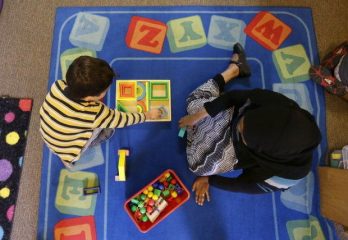Sammy was a bit of a late bloomer. Maria, his mother, spent a lot of time helping him with the kindergarten readiness activities, but she wasn’t sure if he was really prepared. The morning of the first day of school was a whirlwind for the family. Maria dropped Sammy off with a kiss, then made her way to work, where she worried about him off and on all day.
While many of us focus on the basics of letter and number recognition or reading skills, kindergarten readiness encompasses more than a few isolated skills. We need to look at the whole child and all the skills and strengths each child has developed. That’s what makes them unique. As an example, Sasha may love books and have exceptional reading abilities, but she struggles with shyness that prevents her from engaging with other children. Joshua might be very strong socially but still has difficulty holding and using a pencil correctly. Emma can do both these things, but she can be very silly and wiggly and gets distracted in group settings. Despite these differences, all of these children are ready for school.
Here are some tips to help you prepare your child for Kindergarten:
- Help him to develop independence at home. Encourage your child to dress himself, take his coat on and off and hang it up, use the bathroom without assistance and wash his hands without constant reminders, and put on his own shoes. Provide serving spoons so your child can serve himself at the table and clear his own dishes. These skills will take him from the coatroom to the lunchroom and beyond.
- Focus on self-help skills. Your child should know how to wipe her face after lunch without prompting and blow her nose without assistance. But be sure she is also comfortable asking an adult for help when necessary.
- Teach responsibility. Start transferring small responsibilities over to your child, if you haven’t already. After a family trip to the pool, you might put your child in charge of emptying the backpack, refilling the water bottles, or hanging up his wet swimsuit. Even when it may be easier for you to complete these tasks, let him accept the responsibility.
- Develop and follow routines. Set up morning routines that will transfer into a school setting. Getting up around the same time every day, getting dressed, and having an early breakfast together is a great way to transition to school.
- Read aloud to your child. Get your child a library card, take her to the library to check out books, and be sure to read to your child every day. Read a variety of books, read the captions under pictures in the newspaper, even share the comics. Just read!
- Engage her in meaningful literacy activities. Encourage your child to help you with thank you cards, shopping lists, or notes. They may start with scribbles or pictures, move into scattered letters, and finally some recognizable words as they enter school. Appreciate their attempts and watch their skills develop with practice.
- Acknowledge his feelings. Avoid talking about school too much, or wait until the end of summer is near. Your child may express being nervous, not wanting to go or, alternately, feeling very excited to start school. Whatever they feel, take time to appreciate where they are.
Rather than worry about whether your child is ready to read and write, think about his or her skills as a whole. What can they do well that will help them succeed? The quiet child who has reading abilities will find her way to the social butterfly that needs help writing his name. The silly, wiggly child will find a spot as the classroom helper. Rest assured, they will all navigate kindergarten together.
Tracy Galuski is an associate professor and mentor at Empire State College where she shares her experiences as a mother, teacher, and child care administrator with her early childhood students. She teaches online courses in child development and classroom environments.











